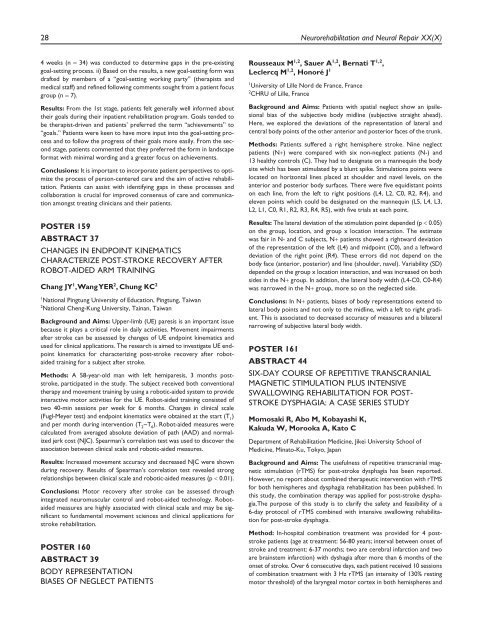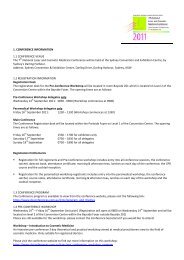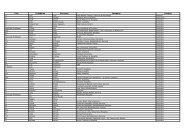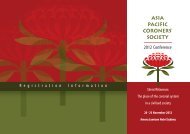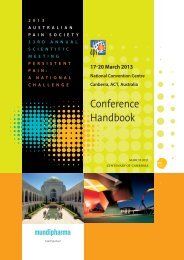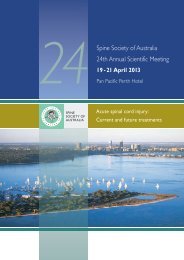WCNR 2012 Poster Abstracts - DC Conferences
WCNR 2012 Poster Abstracts - DC Conferences
WCNR 2012 Poster Abstracts - DC Conferences
Create successful ePaper yourself
Turn your PDF publications into a flip-book with our unique Google optimized e-Paper software.
28 Neurorehabilitation and Neural Repair XX(X)4 weeks (n 34) was conducted to determine gaps in the pre-existinggoal-setting process. ii) Based on the results, a new goal-setting form wasdrafted by members of a “goal-setting working party” (therapists andmedical staff) and refined following comments sought from a patient focusgroup (n 7).Results: From the 1st stage, patients felt generally well informed abouttheir goals during their inpatient rehabilitation program. Goals tended tobe therapist-driven and patients’ preferred the term “achievements” to“goals.” Patients were keen to have more input into the goal-setting processand to follow the progress of their goals more easily. From the secondstage, patients commented that they preferred the form in landscapeformat with minimal wording and a greater focus on achievements.Conclusions: It is important to incorporate patient perspectives to optimizethe process of person-centered care and the aim of active rehabilitation.Patients can assist with identifying gaps in these processes andcollaboration is crucial for improved consensus of care and communicationamongst treating clinicians and their patients.POSTER 159ABSTRACT 37CHANGES IN ENDPOINT KINEMATICSCHARACTERIZE POST-STROKE RECOVERY AFTERROBOT-AIDED ARM TRAININGChang JY 1 , Wang YER 2 , Chung KC 21 National Pingtung University of Education, Pingtung, Taiwan2 National Cheng-Kung University, Tainan, TaiwanBackground and Aims: Upper-limb (UE) paresis is an important issuebecause it plays a critical role in daily activities. Movement impairmentsafter stroke can be assessed by changes of UE endpoint kinematics andused for clinical applications. The research is aimed to investigate UE endpointkinematics for characterizing post-stroke recovery after robotaidedtraining for a subject after stroke.Methods: A 58-year-old man with left hemiparesis, 3 months poststroke,participated in the study. The subject received both conventionaltherapy and movement training by using a robotic-aided system to provideinteractive motor activities for the UE. Robot-aided training consisted oftwo 40-min sessions per week for 6 months. Changes in clinical scale(Fugl-Meyer test) and endpoint kinematics were obtained at the start (T 1)and per month during intervention (T 2~T 6). Robot-aided measures werecalculated from averaged absolute deviation of path (AAD) and normalizedjerk cost (NJC). Spearman’s correlation test was used to discover theassociation between clinical scale and robotic-aided measures.Results: Increased movement accuracy and decreased NJC were shownduring recovery. Results of Spearman’s correlation test revealed strongrelationships between clinical scale and robotic-aided measures (p 0.01).Conclusions: Motor recovery after stroke can be assessed throughintegrated neuromuscular control and robot-aided technology. Robotaidedmeasures are highly associated with clinical scale and may be significantto fundamental movement sciences and clinical applications forstroke rehabilitation.POSTER 160ABSTRACT 39BODY REPRESENTATIONBIASES OF NEGLECT PATIENTSRousseaux M 1,2 , Sauer A 1,2 , Bernati T 1,2 ,Leclercq M 1,2 , Honoré J 11 University of Lille Nord de France, France2 CHRU of Lille, FranceBackground and Aims: Patients with spatial neglect show an ipsilesionalbias of the subjective body midline (subjective straight ahead).Here, we explored the deviations of the representation of lateral andcentral body points of the other anterior and posterior faces of the trunk.Methods: Patients suffered a right hemisphere stroke. Nine neglectpatients (N) were compared with six non-neglect patients (N-) and13 healthy controls (C). They had to designate on a mannequin the bodysite which has been stimulated by a blunt spike. Stimulations points werelocated on horizontal lines placed at shoulder and navel levels, on theanterior and posterior body surfaces. There were five equidistant pointson each line, from the left to right positions (L4, L2, C0, R2, R4), andeleven points which could be designated on the mannequin (L5, L4, L3,L2, L1, C0, R1, R2, R3, R4, R5), with five trials at each point.Results: The lateral deviation of the stimulation point depended (p 0.05)on the group, location, and group x location interaction. The estimatewas fair in N- and C subjects, N patients showed a rightward deviationof the representation of the left (L4) and midpoint (C0), and a leftwarddeviation of the right point (R4). These errors did not depend on thebody face (anterior, posterior) and line (shoulder, navel). Variability (SD)depended on the group x location interaction, and was increased on bothsides in the N group. In addition, the lateral body width (L4-C0, C0-R4)was narrowed in the N group, more so on the neglected side.Conclusions: In N patients, biases of body representations extend tolateral body points and not only to the midline, with a left to right gradient.This is associated to decreased accuracy of measures and a bilateralnarrowing of subjective lateral body width.POSTER 161ABSTRACT 44SIX-DAY COURSE OF REPETITIVE TRANSCRANIALMAGNETIC STIMULATION PLUS INTENSIVESWALLOWING REHABILITATION FOR POST-STROKE DYSPHAGIA: A CASE SERIES STUDYMomosaki R, Abo M, Kobayashi K,Kakuda W, Morooka A, Kato CDepartment of Rehabilitation Medicine, Jikei University School ofMedicine, Minato-Ku, Tokyo, JapanBackground and Aims: The usefulness of repetitive transcranial magneticstimulation (rTMS) for post-stroke dysphagia has been reported.However, no report about combined therapeutic intervention with rTMSfor both hemispheres and dysphagia rehabilitation has been published. Inthis study, the combination therapy was applied for post-stroke dysphagia.Thepurpose of this study is to clarify the safety and feasibility of a6-day protocol of rTMS combined with intensive swallowing rehabilitationfor post-stroke dysphagia.Method: In-hospital combination treatment was provided for 4 poststrokepatients (age at treatment: 56-80 years; interval between onset ofstroke and treatment: 6-37 months; two are cerebral infarction and twoare brainstem infarction) with dyshagia after more than 6 months of theonset of stroke. Over 6 consecutive days, each patient received 10 sessionsof combination treatment with 3 Hz rTMS (an intensity of 130% restingmotor threshold) of the laryngeal motor cortex in both hemispheres and


